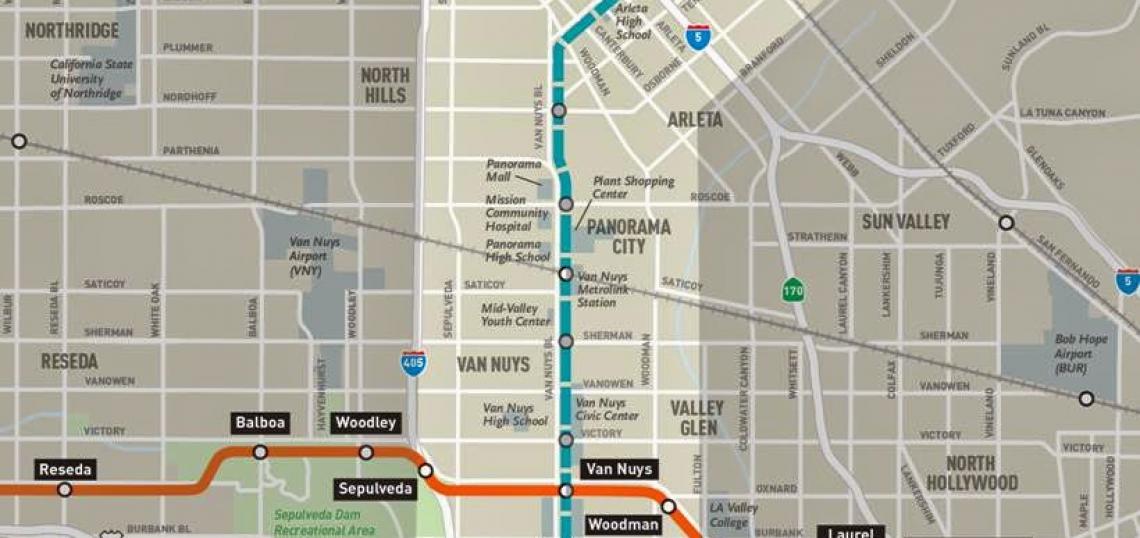Though its June 2018 opening date looms on the distant horizon, few details regarding the East San Fernando Valley Transit Corridor (ESFVTC) are set in stone. The project, partially funded through $170 million in Measure R revenue, will improve public transportation along a nine-mile swath between the Orange Line busway and Sylmar. The proposed transit line would serve an area which is home to over 460,000 people--a larger total than either the cities of Atlanta and Miami. Approximately 35% of residents within this region are deemed transit dependent, a fact which is exemplified by the high level of bus ridership along Van Nuys Boulevard.
Metro is currently compiling a draft environmental impact report for the project, which will study six different options for the ESFVTC. These alternatives include: 1) no-build, 2) transportation systems management, 3) curb-running bus rapid transit, 4) median-running bus rapid transit, 5) low-floor light rail transit/tram, and 6) median-running light rail transit. Although the eventual mode of transportation remains undetermined, a series of artistic renderings portray the hypothetical changes which could be wrought through the project.
Curb-Running Bus Rapid Transit
Budgeted at $294 million, curb-running bus rapid transit would be the fastest and least expensive alternative to implement. Conceptually similar to the ongoing Wilshire BRT project, the curb-running option would entail 6.7 miles of bus-only lanes along Van Nuys Boulevard, supplemented by mix-flow operations along Truman Street and San Fernando Road. An end-to end trip under this alternative is expected to take 41 minutes, based on 2040 proejctions.
The project would include 18 stations, each of which would feature ticket vending machines and weather-shielding canopies. Ridership projections indicate that approximately 30,900 passengers would utilize the curb-running alternative by 2040.
Median-Running Bus Rapid Transit
Median-running bus rapid transit is also being considered for the ESFVTC, with an estimated cost of $402 million. The project would function similarly to Metro's Silver Line bus, with 6.7 miles of median busway lanes and 2.5 miles of mixed-flow operations. End-to-end travel times for this option are estimated at 37 minutes, a slightly speedier figure than the curb-running alternative.
The Median-running BRT alternative would consist of 17 stations, each of which would feature ticket vending machines and canopies. An estimated 31,500 daily passengers would utilize the the busway by 2040.
Low-Floor Light Rail Transit/Tram
Metro is also studying a $1.2 billion tram line for the ESFVTC, similar in concept to the Portland Streetcar. Like the aforementioned BRT alternatives, the project would feature 6.7 miles of dedicated guideway and 2.5 miles of mixed-flow operations between Sylmar the the Orange Line busway. End-to-end travel times are estimated at 42 minutes, based on anticipated 2040 conditions.
The tram alternative would operate in similar fashion to a local bus, with 28 stations along its approximately nine-mile route. An estimated 35,800 daily passengers would ride the proposed streetcar.
Light Rail Transit
The most expensive alternative, and perhaps the most popular, is light rail transit. Budgeted at $2.6 billion, the proposed rail line would run on a 9.2-mile exclusive right-of-way, first alongside existing railroad tracks and then within the wide median of Van Nuys Boulevard. The light rail alternative calls for 2.5 miles of subway, plunging underground just north of Parthenia Street and returning to street level south of Sherman Way.
The light rail alternative, featuring just 14 stations, would offer an end-to-end travel time of 29 minutes, eight minutes faster than any other option on the table. Unsurprisingly, a light rail line also carries the highest anticipated ridership of the alternatives under study, with an estimated 47,400 daily passengers by the year 2040.
Like its BRT counterparts, the light rail alternative would run between the Sylmar/San Fernando Metrolink Station and the Orange Line Busway. The project may also interface with the future Sepulveda Pass Transit Corridor, which is studying multiple options for transportation improvements through the infamous traffic bottleneck.
However, the ESFVTC's light rail alternative also carries its fair share of drawbacks. Completely isolated from Metro's existing maintenance facilities, the project would require the construction of a new rail yard. Metro has proposed three candidate sites for the hypothetical maintenance facility, two of which abut the Van Nuys Metrolink Station, and one located southwest of the Orange Line busway.
Cost will likely prove to be the most substantial obstacle for the project. Although light rail offers superior travel times and ridership estimates, Measure R provides just $170 million in seed money for the ESFVTC. While that figure may put the two BRT alternatives within range, it comes nowhere close to the $2.6 billion cost of the proposed rail line. While Metro has proven adept at securing federal grants to build its ambitious slate of Measure R projects, a multi-billion dollar funding gap will be difficult to overcome.
A potential solution to this problem could be found in a future transportation ballot initiative. Transit advocacy group Move LA has developed a strawman proposal for Measure R2, which would utilize a half-cent, 45-year sales tax to fund transportation improvements throughout Los Angeles County. The proposed ballot initiative could infuse new money into several underfunded projects, including the Sepulveda Pass and East San Fernando Valley Transit Corridors.






